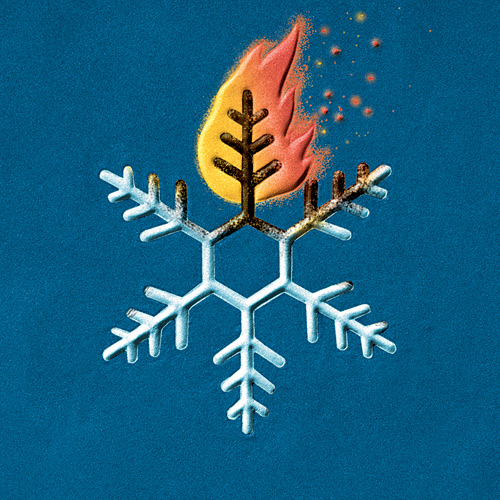Jim Woodmency knows something about the risks of predicting winter weather to the season’s ardent disciples. The man behind Jackson Hole’s Mountain Weather gets graded every time.
If Woodmency under-predicts a snowfall, people say, “Hallelujah, the weatherman was wrong!” If he over-predicts, and folks turn up at the lifts with their fatties for what amounts to a six-inch touch-up, the quips come fast and furious: “Say, Jim, what did you do with the other six inches?” Woodmency says it’s difficult enough knowing what the weather will do tomorrow, let alone in 30 days. But what about 20 to 30 years from now?
“Thirty years?” Woodmency ponders. “What I worry about is saying anything that might lead people to say, ‘The guy’s a denier.’” What he means is “global warming denier.”

Illustration by Alex Nabaum
Most climate experts predict that winter in the mountains won’t be dramatically different for the next couple of decades. Even though the average temperature is rising, we’re in for snowy winters and less snowy winters—just like we’ve always had—for the next generation or so.
Take early December in northern Vermont this year. For weeks, the ground surrounding my home was bare, temperatures were hitting 50°, and there wasn’t any snow in the forecast. Aha! Evidence of global warming, some will surely argue.
Similarly, in past seasons, when the eaves on my house creaked under five feet of snow and temperatures didn’t break 20° for a week, deniers could gleefully say: see, no global warming!
So, what will winter look like in 20 to 30 years? The planet is getting warmer, although by how much remains in dispute. But whether it’s two degrees warmer on average or four, winters will keep coming, along with seasonal variations.
In Jackson Hole, for instance, the current average January high is 28° and the average low is 6°. If the average in 20 years goes up maximum of 2° to 3°, which is what some climatologists predict, snow remains in the forecast.
“The long-term trend is moderating temperatures. Accelerating, moderating temperatures,” says Nick Bond, Washington State’s climatologist and the senior climate science researcher at the University of Washington. “It’s going to be two to four degrees warmer in 2040, on average.”
“There will be fluctuations around that [average temperature] baseline,” Bond says, echoing climate scientists in Europe and New England. “Those fluctuations can and will mask the general trend, which will be warmer.”
At the risk of playing into the deniers’ arguments, the rest of the good news for skiers is that the mountains will be a wise choice to call home. Scientists predict that weather extremes—droughts, floods, hurricanes, rising sea levels, acidified ocean waters—will be more pronounced as the globe—the atmosphere and particularly the oceans—warms. Coastlines will feel the catastrophic effects more than the mountains.
Winter, however, is warming. It won’t vanish in your children’s lifetimes, or even in your grandchildren’s, at least not according to most scientists, but winter snow cover is shrinking. And so are glaciers.
“Glaciers are disappearing fast in the Alps and actually pretty much everywhere else,” says Bill McKibben, cofounder of the climate-change advocacy group 350.org. “Big ones [glaciers] will get smaller, and smaller ones will disappear. There’s going to have to be a contest for a new name for the national-park-formerly-known-as-Glacier.”
Those in the European Alps have been among the hardest hit, some having already retreated by more than 50 percent since the industrial revolution. But, in keeping with the 20- to 30-year prediction of weather fluctuations within an overall warming trend, the retreat of Europe’s glaciers actually slowed almost to a complete halt from 2011 to 2015 due to cold, snowy winters and particularly snowy springs. A few glaciers actually advanced very slightly.
In addition to receding, glaciers can also shrink in thickness, sometimes by dozens of feet. Some passes and cols—the Adlerpass between Saas Fe and Zermatt, for example—once accessible by a gentle skin up a glacier are now steep rock faces, says Swiss-Canadian ski guide John Hoggs, who’s been guiding in the Rockies and Alps for 35 years: “All of my guiding books for the Alps, most of the ones I got when I first started guiding there, I could just throw them away now.”
With glaciers vanishing, winters’ unpredictable ups and downs, the inclination is to grab a flight to Japan or Europe, or some safe, cold place, and get it while you can. But consider this: plane travel is one of the greatest contributors to planet-warming carbon emissions. You’d be helping to cook the metaphoric golden goose by chasing it. Which is why staying close to home and earning your turns seems to be the moral of this story.
The challenge with any discussion about climate change is that the data changes quickly and not necessarily in favor of cold, snowy winters. Since the original reporting and writing of this article in November 2015, the U.S. National Oceanic and Atmospheric Administration and NASA calculated that 2015 was the hottest year since records first began in 1880. That was expected; it is the extent of the warming last year that was startling. The average temperature across the planet rose 1.62 degrees Fahrenheit, or .90 degrees Celsius above the 20th Century average, more than 20 percent higher than the previous annual average increase. What’s more, December was the first month to ever reach 2 degrees Fahrenheit above the normal average for the globe—even as historic snowstorms slammed the Washington DC area. Climate scientists this month announced that sea levels are now rising faster than they have in 2,800 years.
Biddle Duke has written, edited and run newspapers and magazines in New York, New Mexico, Argentina, South Carolina and Vermont and has been searching for that elusive perfect day in the mountains since the era of Salomon rear-entries and the Ramer Model RS. He’s lived in Vermont for 18 years with his artist wife, Idoline, and mutt, Ralphie, where he writes, cooks and carefully consumes the world’s best beer (State slogan: Vermont, the Napa of beer).
—
To get the February/March issue, visit the Backcountry Magazine store.










Super and informative article! Thank you Biddle Duke.